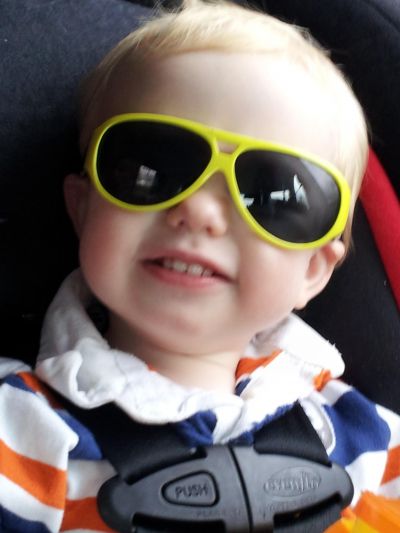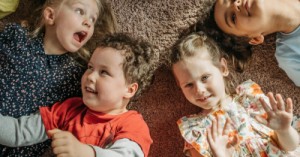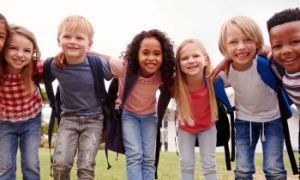This is a guide for educators on what to observe under each sub learning outcome from the EYLF Framework, when a child is engaged in play and learning. Educators can plan experiences for the curriculum and for individual learning and gain an understanding on how children can achieve each individual outcome.
Learning Outcome 1 - Children have a strong sense of identity
1.1 Children feel safe, secure, and supported
This is evident when children:
- build secure attachments with one and then more familiar educators.
- use effective routines to help make predicted transitions smoothly.
- sense and respond to a feeling of belonging.
- communicate their needs for comfort and assistance.
- establish and maintain respectful, trusting relationships with other children and educators.
- openly express their feelings and ideas in their interactions with others.
- respond to ideas and suggestions from others.
- initiate interactions and conversations with trusted educators.
- confidently explore and engage with social and physical environments through relationships and play.
- initiate and join in play.
- explore aspects of identity through role play.
1.2 Children develop their emerging autonomy, inter-dependence, resilience and sense of agency
This is evident when children:
- demonstrate increasing awareness of the needs and rights of others.
- be open to new challenges and discoveries.
- increasingly co-operate and work collaboratively with others.
- take considered risk in their decision-making and cope with the unexpected.
- recognize their individual achievements and the achievements of others.
- demonstrate an increasing capacity for self-regulation.
- approach new safe situations with confidence.
- begin to initiate negotiating and sharing Behaviors.
- persist when faced with challenges and when first attempts are not successful.
1.3 Children develop knowledgeable and confident self identities
This is evident when children:
- feel recognised and respected for who they are.
- explore different identities and points of view in dramatic play.
- share aspects of their culture with the other children and educators.
- use their home language to construct meaning.
- develop strong foundations in both the culture and language/s of their family and of the broader community without compromising their cultural identities.
- develop their social and cultural heritage through engagement with Elders and community members.
- reach out and communicate for comfort, assistance and companionship.
- celebrate and share their contributions and achievements with others.
1.4 Children learn to interact in relation to others with care, empathy and respect
This is evident when children:
- show interest in other children and being part of a group.
- engage in and contribute to shared play experiences.
- express a wide range of emotions, thoughts and views constructively.
- empathize with and express concern for others.
- display awareness of and respect for others’ perspectives.
- reflect on their actions and consider consequences for others.
Learning Outcome 2: Children are connected with and contribute to their world
2.1 Children develop a sense of belonging to groups and communities and an understanding of the reciprocal rights and responsibilities necessary for active community participation
This is evident when children:
- begin to recognize that they have a right to belong to many communities.
- cooperate with others and negotiate roles and relationships in play episodes and group experiences.
- take action to assist other children to participate in social groups.
- broaden their understanding of the world in which they live.
- express an opinion in matters that affect them.
- build on their own social experiences to explore other ways of being.
- participate in reciprocal relationships.
- gradually learn to ‘read’ the behaviors of others and respond appropriately.
- understand different ways of contributing through play and projects.
- demonstrate a sense of belonging and comfort in their environments.
- are playful and respond positively to others, reaching out for company and friendship.
- contribute to fair decision-making about matters that affect them.
2.2 Children respond to diversity with respect
This is evident when children:
- begin to show concern for others.
- explore the diversity of culture, heritage, background and tradition and that diversity presents opportunities for choices and new understandings.
- become aware of connections, similarities and differences between people.
- listen to others’ ideas and respect different ways of being and doing.
- practice inclusive ways of achieving coexistence.
- notice and react in positive ways to similarities and differences among people.
2.3 Children become aware of fairness
This is evident when children:
- discover and explore some connections amongst people.
- become aware of ways in which people are included or excluded from physical and social environments.
- develop the ability to recognize unfairness and bias and the capacity to act with compassion and kindness.
- are empowered to make choices and problem solve to meet their needs in particular contexts.
- begin to think critically about fair and unfair behavior.
- begin to understand and evaluate ways in which texts construct identities and create stereotypes.
2.4 Children become socially responsible and show respect for the environment
This is evident when children:
- use play to investigate, project and explore new ideas.
- participate with others to solve problems and contribute to group outcomes.
- demonstrate an increasing knowledge of and respect for natural and constructed environments.
- explore, infer, predict and hypothesize in order to develop an increased understanding of the interdependence between land, people, plants and animals.
- show growing appreciation and care for natural and constructed environments.
- explore relationships with other living and non-living things and observe, notice and respond to change.
- develop an awareness of the impact of human activity on environments and the interdependence of living things.
Learning Outcome 3: Children have a strong sense of wellbeing
3.1 Children become strong in their social and emotional wellbeing
This is evident when children:
- demonstrate trust and confidence.
- remain accessible to others at times of distress, confusion and frustration.
- share humor, happiness and satisfaction.
- seek out and accept new challenges, make new discoveries, and celebrate their own efforts and achievements and those of others.
- increasingly co-operate and work collaboratively with others.
- enjoy moments of solitude.
- recognize their individual achievement.
- make choices, accept challenges, take considered risks, manage change and cope with frustrations and the unexpected.
- show an increasing capacity to understand, self-regulate and manage their emotions in ways that reflect the feelings and needs of others.
- experience and share personal successes in learning and initiate opportunities for new learning in their home languages or Standard Australian English.
- acknowledge and accept affirmation.
- assert their capabilities and independence while demonstrating increasing awareness of the needs and rights of others.
- recognize the contributions they make to shared projects and experiences.
3.2 Children take increasing responsibility for their own health and physical wellbeing
This is evident when children:
- recognise and communicate their bodily needs (for example, thirst, hunger, rest, comfort, physical activity).
- are happy, healthy, safe and connected to others.
- engage in increasingly complex sensory motor skills and movement patterns.
- combine gross and fine motor movement and balance to achieve increasingly complex patterns of activity including dance, creative movement and drama.
- use their sensory capabilities and dispositions with increasing integration, skill and purpose to explore and respond to their world.
- demonstrate spatial awareness and orient themselves, moving around and through their environments confidently and safely.
- manipulate equipment and manage tools with increasing competence and skill respond through movement to traditional and contemporary music, dance and storytelling.
- show an increasing awareness of healthy lifestyles and good nutrition.
- show increasing independence and competence in personal hygiene, care and safety for themselves and others.
- show enthusiasm for participating in physical play and negotiate play spaces to ensure the safety and wellbeing of themselves and others.
Learning Outcome 4: Children are confident and involved learners
4.1 Children develop dispositions for learning such as curiosity, cooperation, confidence, creativity, commitment, enthusiasm, persistence, imagination and reflexivity
This is evident when children:
- express wonder and interest in their environments.
- are curious and enthusiastic participants in their learning.
- use play to investigate, imagine and explore ideas.
- follow and extend their own interests with enthusiasm, energy and concentration.
- initiate and contribute to play experiences emerging from their own ideas.
- participate in a variety of rich and meaningful inquiry-based experiences.
- persevere and experience the satisfaction of achievement.
- persist even when they find a task difficult.
4.2 Children develop a range of skills and processes such as problem solving, inquiry, experimentation, hypothesising, researching and investigating
This is evident when children:
- apply a wide variety of thinking strategies to engage with situations and solve problems, and adapt these strategies to new situations.
- create and use representation to organize, record and communicate mathematical ideas and concepts.
- make predictions and generalizations about their daily activities, aspects of the natural world and environments, using patterns they generate or identify and communicate these using mathematical language and symbols.
- explore their environment.
- manipulate objects and experiment with cause and effect, trial and error, and motion.
- contribute constructively to mathematical discussions and arguments.
- use reflective thinking to consider why things happen and what can be learnt from these experience.
4.3 Children transfer and adapt what they have learned from one context to another
This is evident when children:
- engage with and co-construct learning.
- develop an ability to mirror, repeat and practice the actions of others, either immediately or later.
- make connections between experiences, concepts and processes.
- use the processes of play, reflection and investigation to solve problems.
- apply generalizations from one situation to another.
- try out strategies that were effective to solve problems in one situation in a new context.
- transfer knowledge from one setting to another.
4.4 Children resource their own learning through connecting with people, place, technologies and natural and processed materials
This is evident when children:
- engage in learning relationships.
- use their senses to explore natural and built environments.
- experience the benefi ts and pleasures of shared learning exploration.
- explore the purpose and function of a range of tools, media, sounds and graphics.
- manipulate resources to investigate, take apart, assemble, invent and construct.
- experiment with different technologies.
- use information and communication technologies (ICT) to investigate and problem solve.
- explore ideas and theories using imagination, creativity and play.
- use feedback from themselves and others to revise and build on an idea.
Learning Outcome 5: Children are effective communicators
5.1 Children interact verbally and non-verbally with others for a range of purposes
This is evident when children:
- engage in enjoyable interactions using verbal and non-verbal language.
- convey and construct messages with purpose and confidence, building on home/family and community literacies.
- respond verbally and non-verbally to what they see, hear, touch, feel and taste.
- use language and representations from play, music and art to share and project meaning.
- contribute their ideas and experiences in play, small and large group discussions.
- attend and give cultural cues that they are listening to and understanding what is said to them.
- are independent communicators who initiate Standard Australian English and home language conversations and demonstrate the ability to meet the listeners’ needs.
- interact with others to explore ideas and concepts, clarify and challenge thinking, negotiate and share new understandings.
- convey and construct messages with purpose and confidence, building on literacies of home/family and the broader community.
- exchange ideas, feelings and understandings using language and representations in play.
- demonstrate an increasing understanding of measurement and number using vocabulary to describe size, length, volume, capacity and names of numbers.
- express ideas and feelings and understand and respect the perspectives of others.
- use language to communicate thinking about quantities to describe attributes of objects and collections, and to explain mathematical Ideas.
- show increasing knowledge, understanding and skill in conveying meaning in at least one language.
5.2 Children engage with a range of texts and gain meaning from these texts
This is evident when children:
- listen and respond to sounds and patterns in speech, stories and rhymes in context.
- view and listen to printed, visual and multimedia texts and respond with relevant gestures, actions, comments and/or questions.
- sing and chant rhymes, jingles and songs.
- take on roles of literacy and numeracy users in their play.
- begin to understand key literacy and numeracy concepts and processes, such as the sounds of language, letter-sound relationships, concepts of print and the ways that texts are structured.
- explore texts from a range of different perspectives and begin to analyze the meanings.
- actively use, engage with and share the enjoyment of language and texts in a range of ways.
- recognize and engage with written and oral culturally constructed texts.
5.3 Children express ideas and make meaning using a range of media
This is evident when children:
- use language and engage in play to imagine and create roles, scripts and ideas.
- share the stories and symbols of their own culture and re-enact well-known stories.
- use the creative arts such as drawing, painting, sculpture, drama, dance, movement, music and storytelling to express ideas and make meaning.
- experiment with ways of expressing ideas and meaning using a range of media.
- begin to use images and approximations of letters and words to convey meaning.
5.4 Children begin to understand how symbols and pattern systems work
This is evident when children:
- use symbols in play to represent and make meaning.
- begin to make connections between and see patterns in their feelings, ideas, words and actions and those of others.
- notice and predict the patterns of regular routines and the passing of time.
- develop an understanding that symbols are a powerful means of communication and that ideas, thoughts and concepts can be represented through them.
- begin to be aware of the relationships between oral, written and visual representations.
- begin to recognize patterns and relationships and the connections between them.
- begin to sort, categorize, order and compare collections and events and attributes of objects and materials, in their social and natural worlds.
- listen and respond to sounds and patterns in speech, stories and rhyme.
- draw on memory of a sequence to complete a task.
- draw on their experiences in constructing meaning using symbols.
5.5 Children use information and communication technologies to access information, investigate ideas and represent their thinking
This is evident when children:
- identify the uses of technologies in everyday life and use real or imaginary technologies as props in their play.
- use information and communication technologies to access images and information, explore diverse perspectives and make sense of their world.
- use information and communication technologies as tools for designing, drawing, editing, reflecting and composing.
- engage with technology for fun and to make meaning.







 Here is the list of the EYLF Learning Outcomes that you can use as a guide or reference for your documentation and planning. The EYLF
Here is the list of the EYLF Learning Outcomes that you can use as a guide or reference for your documentation and planning. The EYLF The EYLF is a guide which consists of Principles, Practices and 5 main Learning Outcomes along with each of their sub outcomes, based on identity,
The EYLF is a guide which consists of Principles, Practices and 5 main Learning Outcomes along with each of their sub outcomes, based on identity, This is a guide on How to Write a Learning Story. It provides information on What Is A Learning Story, Writing A Learning Story, Sample
This is a guide on How to Write a Learning Story. It provides information on What Is A Learning Story, Writing A Learning Story, Sample One of the most important types of documentation methods that educators needs to be familiar with are “observations”. Observations are crucial for all early childhood
One of the most important types of documentation methods that educators needs to be familiar with are “observations”. Observations are crucial for all early childhood To support children achieve learning outcomes from the EYLF Framework, the following list gives educators examples of how to promote children's learning in each individual
To support children achieve learning outcomes from the EYLF Framework, the following list gives educators examples of how to promote children's learning in each individual Reflective practice is learning from everyday situations and issues and concerns that arise which form part of our daily routine while working in an early
Reflective practice is learning from everyday situations and issues and concerns that arise which form part of our daily routine while working in an early Within Australia, Programming and Planning is reflected and supported by the Early Years Learning Framework. Educators within early childhood settings, use the EYLF to guide
Within Australia, Programming and Planning is reflected and supported by the Early Years Learning Framework. Educators within early childhood settings, use the EYLF to guide When observing children, it's important that we use a range of different observation methods from running records, learning stories to photographs and work samples. Using
When observing children, it's important that we use a range of different observation methods from running records, learning stories to photographs and work samples. Using This is a guide for educators on what to observe under each sub learning outcome from the EYLF Framework, when a child is engaged in
This is a guide for educators on what to observe under each sub learning outcome from the EYLF Framework, when a child is engaged in The Early Years Learning Framework describes the curriculum as “all the interactions, experiences, activities, routines and events, planned and unplanned, that occur in an environment
The Early Years Learning Framework describes the curriculum as “all the interactions, experiences, activities, routines and events, planned and unplanned, that occur in an environment


